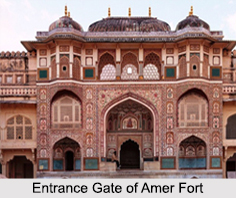 Gates of Rajasthan are minutely decorated with Rajasthani culture which reached at its acme when India was under the dark age of Mughal rule. From the era of Delhi Sultanate, the Rajputana was the hot seat for Rajputs. They were mostly Hindus and Jains. These gates are some victory gates, sacrifice gates or the entrance to gigantic and magnificent forts, which are now converted into the museums.
Gates of Rajasthan are minutely decorated with Rajasthani culture which reached at its acme when India was under the dark age of Mughal rule. From the era of Delhi Sultanate, the Rajputana was the hot seat for Rajputs. They were mostly Hindus and Jains. These gates are some victory gates, sacrifice gates or the entrance to gigantic and magnificent forts, which are now converted into the museums.
Entrance gate of Amer Fort of Rajasthan
The entry gate of Amer Fort is known for its artistic Hindu style elements in medieval India. The entire fort of Amer was formed with large ramparts and series of gates and cobbled paths. The fort overlooks Maota Lake.
Suraj Pole of Rajasthan
The Suraj Pol is the main entry to Amer Fort. It is known as the "Sun Gate" which leads to Jalebi Chowk, the first main courtyard. This was the place where armies would hold victory parades with their war bounty on their return from battles, which were also witnessed by the Royal family`s women folk through the latticed windows. This gate was built exclusively and was provided with guards as it was the main entry into the palace.
Tripolia Gate of Rajasthan
Tripolia gate means three gates. It is an access to the palace of Amer from the west. It opens in three directions, one to the Jaleb Chowk, another to the Man Singh Palace and the third one to the Zenana Deorhi on the south.
Lion Gate of Rajasthan
Lion gate which is known as the premier gate in Amer Fort was once a guarded gate. It leads to the private quarters in the palace premises and is titled `Lion Gate` to suggest strength. Lion gate was built during the reign of Sawai Jai Singh. It is covered with frescoes. Its alignment is zigzag, probably made so from security considerations to attack intruders.
 Gateway of Jaigarh Fort of Rajasthan
Gateway of Jaigarh Fort of Rajasthan
The Gateway of Jaigarh Fort shows the example of early Rajputana sculptural work. The fort stands on a short diversion from the Jaipur-Delhi Highway, which leads to the Jaivana cannon at the Dungar Darwaza.
Dungar Darwazaof Rajasthan
Dungar Darwaza in Jaigarh Fort leads to another important fort called the Nahargarh Fort. It can also be approached from the Amer Fort over a short climb along a steep hill track, arriving at the Awami Gate near the fort museum.
Entrance of Kumbhalgarh Fort of Rajasthan
The entrance of Kumbhalgarh Fort is known for the unique architecture. It is a World Heritage Site included in Hill Forts of Rajasthan. Kumbhalgarh fort has seven fortified gateways.
Entrance of Mehrangarh Fort of Rajasthan
The entrance of Mehrangarh Fort was made up of unique metal work and stone cult. This fort is located in Jodhpur, Rajasthan and it is known as one of the largest forts in India. There are seven gates in Mehrangarh fort.
Jai Pol of Rajasthan
Jai Pol which is known as "Gate of Victory" was built by Maharaja Man Singh in 1806 to celebrate his victory in a war with Jaipur and Bikaner.
Fateh Pol of Rajasthan
Fateh Pol was built to celebrate a victory over the Mughal Empire in the year 1707.
Dedh Kamgra Pol of Rajasthan
 Dedh Kamgra Pol still bears the scars of bombardment by cannonballs of Mughals against Rajputs.
Dedh Kamgra Pol still bears the scars of bombardment by cannonballs of Mughals against Rajputs.
Loha Pol of Rajasthan
Loha Pol is the final gate into the main part of the fort complex
Chanpori Gate of Rajasthan
Chanpori Gate is the gateway to the walled city of Jaipur.
Sanganeri Gate of Rajasthan
Sanganeri Gate area is now converted as the jewelry market.
Other Gates of Rajasthan
Some other Gates of Rajasthan are enlisted below:
•Chandpole gate, New Gate, Ghat Gate, Samrat Gate, Zorawar Singh Gate, Ganesh Pol at Jaipur.
•Hanuman Pol at Kumbhalgarh, Rajsamand District.
•Jayapol Gate, Dedh Kamgra Pol, Fattehpol and Loha Pol at Mehrangarh Fort in Jodhpur.
•Karan Pol, Suraj Pol, Daulat Pol, Chand Pol at Junagarh Fort, Bikaner.
•Ram Pol, Padan Pol, Bhairon Pol, Hanuman Pol, Ganesh Pol, Jodla Pol, Laxman Pol at Chittor Fort.






